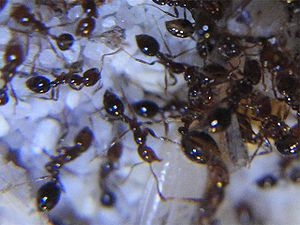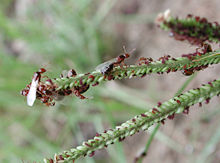Fire ants
| Fire ants | ||||||||||||
|---|---|---|---|---|---|---|---|---|---|---|---|---|

Some Solenopsis sp. Workers |
||||||||||||
| Systematics | ||||||||||||
|
||||||||||||
| Scientific name | ||||||||||||
| Solenopsis | ||||||||||||
| Westwood , 1840 |
The fire ants ( Solenopsis ) or thief ants are a genus of ants (Formicidae) and belong to the subfamily of the knot ants (Myrmicinae).
features
The workers of the fire ants are usually brownish to reddish. The gaster is a bit darker and the head is copper-brown to reddish. They are rather small with a length of around two to six millimeters. The propodeum is rounded at the back and shows minor unevenness, but has no sharp thorns or recesses. The antennas consist of ten segments . The foremost two segments are formed into a distinct club. At the front edge of the frontal plate ( clypeus ) there is a single protruding hair or bristle in the middle.
These ants leave small pus pustules where they bite in the human skin and a burning pain when pricked. The strong poison of fire ants can cause allergic reactions. There is a risk of anaphylactic shock.
Similar species
Fire ants are easy to confuse with representatives from the genus Monomorium , but these do not have the club-shaped thickening of the antennae. Smaller species from the genus Carebara also look similar. However, they have hair arranged in pairs on the edge of the clypeus instead of a single hair that protrudes in the middle. In Carebara, the propodeum also shows clear areas or sharp thorns.
distribution
There are over 140 different species and other subspecies worldwide. A good 80 percent of them live in the Neotropic and the southern Nearctic . There are only a few species in Europe , and the taxonomy is in great need of revision. There is only one known species north of the Alps, the yellow thief ant ( Solenopsis fugax ). In the United States more species are widespread, but was in the 1930s from South America , the red imported fire ant ( Solenopsis invicta ) introduced that continues in North America expands and displaces the native there species, also the red imported fire ant in Australia has spread.
Way of life
Many species become highly polygynous . The colony foundation is done independently by a single queen or in pleometrosis by a few queens. New colonies can consist of several thousand individuals within a few months. The nests are usually made under stones or in the open field. In some species, the nests are directly connected to foreign ant nests. These species live kleptoparasitic and use the foreign food supplies or steal the brood. Fire ants of at least the two species Solenopsis invicta and Solenopsis germinata are able to survive floods because the individual female animals and larvae form a bivouac raft with their bodies .
species
The following fire ant species are currently known:
- Solenopsis abdita Thompson, 1989
- Solenopsis abjectior Pacheco & Mackay, 2013
- Solenopsis africana Santschi, 1914
- Solenopsis alecto Santschi, 1934
- † Solenopsis alena Özdikmen, 2010
- Solenopsis altinodis Forel, 1912
- Solenopsis amblychila Wheeler, 1915
- Solenopsis andina Santschi, 1923
- Solenopsis atlantis Santschi, 1934
- Solenopsis aurea Wheeler, 1906
- Solenopsis azteca Forel, 1893
- Solenopsis basalis Forel, 1895
- Solenopsis belisarius Forel, 1907
- Solenopsis bicolor Emery, 1906
- † Solenopsis blanda (Forester, 1891)
- Solenopsis brazoensis (Buckley, 1866)
- Solenopsis brevicornis Emery, 1888
- Solenopsis bruchiella Emery, 1922
- Solenopsis bruesi Creighton, 1930
- Solenopsis bucki Kempf, 1973
- Solenopsis canariensis Forel, 1893
- Solenopsis capensis Mayr, 1866
- Solenopsis carolinensis Forel, 1901
- Solenopsis castor Forel, 1893
- Solenopsis celata (Dlussky & Zabelin, 1985)
- Solenopsis clarki Crawley, 1922
- Solenopsis clytemnestra Emery, 1896
- Solenopsis conjurata Wheeler, 1925
- Solenopsis cooperi Donisthorpe, 1947
- Solenopsis corticalis Forel, 1881
- Solenopsis crivellarii Menozzi, 1936
- Solenopsis daguerrei (Santschi, 1930)
- Solenopsis dalli (Kuznetsov, 1969)
- Solenopsis debilior Santschi, 1934
- Solenopsis decipiens Emery, 1906
- Solenopsis dentata Collingwood & Kugler, 1994
- Solenopsis desecheoensis male, 1920
- Solenopsis deserticola Ruzsky, 1905
- Solenopsis dysderces Snelling, 1975
- Solenopsis egregia (Kuznetsov, 1953)
- Solenopsis electra Forel, 1914
- Solenopsis elhawagryi Sharaf & Aldawood, 2012
- Solenopsis emeryi Santschi, 1934
- Solenopsis emiliae Santschi, 1912
- Solenopsis enigmatica Deyrup & Prusak, 2008
- Solenopsis eximia (Kuznetsov, 1953)
- Solenopsis fairchildi Wheeler, 1926
- † Solenopsis foersteri Théobald, 1937
- Solenopsis franki Forel, 1908
- Solenopsis froggatti Forel, 1913
- Yellow thief ant ( Solenopsis fugax ) (Latreille, 1798)
- Solenopsis fusciventris Clark, 1934
- Solenopsis gallica Santschi, 1934
- Solenopsis gayi (Spinola, 1851)
- Solenopsis geminata (Fabricius, 1804)
- Solenopsis gensterblumi Forel, 1901
- Solenopsis georgica Menozzi, 1942
- Solenopsis germaini Emery, 1895
- Solenopsis globularia (Smith, 1858)
- Solenopsis gnoma Pacheco, Herrera & MacKay, 2007
- Solenopsis gnomula Emery, 1915
- Solenopsis goeldii Forel, 1912
- Solenopsis granivora Kuznetsov, 1957
- Solenopsis hayemi Forel, 1908
- Solenopsis helena Emery, 1895
- Solenopsis hostilis (Borgmeier, 1959)
- Solenopsis iheringi Forel, 1908
- Solenopsis ilinei Santschi, 1936
- Solenopsis impolita Moreno-Gonzalez, Mackay & Pacheco, 2013
- Solenopsis indagatrix Wheeler, 1928
- Solenopsis insculpta Clark, 1938
- Solenopsis insinuans Santschi, 1933
- Solenopsis interrupta Santschi, 1916
- Red fire ant ( Solenopsis invicta ) Buren, 1972
- Solenopsis isopilis Pacheco & Mackay, 2013
- Solenopsis jacoti Wheeler, 1923
- Solenopsis jalalabadica Pisarski, 1970
- Solenopsis japonica Wheeler, 1928
- Solenopsis joergenseni Santschi, 1919
- Solenopsis johnsoni Pacheco, Mackay & Moreno-Gonzalez, 2013
- Solenopsis juliae (Arakelian, 1991)
- Solenopsis kabylica Santschi, 1934
- Solenopsis knuti Pisarski, 1967
- Solenopsis kochi Finzi, 1936
- Solenopsis krockowi Wheeler, 1908
- Solenopsis laeviceps Mayr, 1870
- Solenopsis latastei Emery, 1895
- Solenopsis latro Forel, 1894
- Solenopsis leptanilloides Santschi, 1925
- Solenopsis longiceps Forel, 1907
- Solenopsis longinoi Pacheco & Mackay, 2013
- Solenopsis loretana Santschi, 1936
- Solenopsis lotophaga Santschi, 1911
- Solenopsis lou Forel, 1902
- Solenopsis lucayensis Wheeler, 1908
- Solenopsis lusitanica Emery, 1915
- Solenopsis maboya Snelling, 2001
- Solenopsis macdonaghi Santschi, 1916
- Solenopsis macrops Santschi, 1917
- Solenopsis madara Roger, 1863
- Solenopsis major Forel, 1913
- Solenopsis maligna Santschi, 1910
- Solenopsis mameti Donisthorpe, 1946
- Solenopsis marxi Forel, 1915
- Solenopsis maxillosa Emery, 1900
- † Solenopsis maxima (Förster, 1891)
- Solenopsis megera Santschi, 1934
- Solenopsis megergates Trager, 1991
- Solenopsis melina Pacheco & Mackay, 2013
- Solenopsis metanotalis Emery, 1896
- Solenopsis metatarsalis (Kuznetsov, 1957)
- Solenopsis minutissima Emery, 1906
- † Solenopsis moesta (Forester, 1891)
- Solenopsis molesta (Say, 1836)
- Solenopsis mozabensis (Bernard, 1977)
- Solenopsis nickersoni Thompson, 1982
- Solenopsis nigella Emery, 1888
- Solenopsis nitens Bingham, 1903
- Solenopsis nitida (Dlussky & Radchenko, 1994)
- Solenopsis normandi Santschi, 1934
- Solenopsis occipitalis Santschi, 1911
- Solenopsis ocellata Moreno-Gonzalez, Mackay & Pacheco, 2013
- Solenopsis oculata Santschi, 1925
- Solenopsis omana Collingwood & Agosti, 1996
- Solenopsis oraniensis Forel, 1894
- Solenopsis orbula Emery, 1875
- Solenopsis orbuloides André, 1890
- Solenopsis orestes Forel, 1903
- Solenopsis overbecki Viehmeyer, 1916
- Solenopsis pachycera (Forel, 1915)
- Solenopsis papuana Emery, 1900
- Solenopsis parva Mayr, 1868
- Solenopsis patagonica Emery, 1906
- Solenopsis patriciae Pacheco & Mackay, 2013
- Solenopsis pawaensis male, 1919
- Solenopsis pergandei Forel, 1901
- Solenopsis phoretica Davis & Deyrup, 2006
- Solenopsis photophila Santschi, 1923
- Solenopsis picea Emery, 1896
- Solenopsis picquarti Forel, 1899
- Solenopsis picta Emery, 1895
- Solenopsis pilosula Wheeler, 1908
- Solenopsis polita (Smith, 1862)
- Solenopsis pollux Forel, 1893
- † Solenopsis privata (Forester, 1891)
- Solenopsis pulleni Pacheco, Mackay & Moreno-Gonzalez, 2013
- Solenopsis punctaticeps Mayr, 1865
- Solenopsis pusillignis Trager, 1991
- Solenopsis pygmaea Forel, 1901
- Solenopsis pythia Santschi, 1934
- Solenopsis quadridentata Pacheco, Mackay & Moreno-Gonzalez, 2013
- Solenopsis quinquecuspis Forel, 1913
- Solenopsis richteri Forel, 1909
- Solenopsis rugiceps Mayr, 1870
- Solenopsis sabeana (Buckley, 1866)
- Solenopsis saevissima (Smith, 1855)
- Solenopsis salina Wheeler, 1908
- Solenopsis santschii Forel, 1905
- Solenopsis saudiensis Sharaf & Aldawood, 2011
- Solenopsis schilleri Santschi, 1923
- Solenopsis scipio Santschi, 1911
- Solenopsis sea (Kuznetsov, 1953)
- Solenopsis seychellensis Forel, 1909
- Solenopsis shiptoni Forel, 1914
- Solenopsis solenopsidis (Kusnezov, 1953)
- Solenopsis soochowensis Wheeler, 1921
- Solenopsis striata Pacheco & Mackay, 2013
- Solenopsis stricta Emery, 1896
- Solenopsis substituta Santschi, 1925
- Solenopsis subterranea MacKay & Vinson, 1989
- Solenopsis subtilis Emery, 1896
- Solenopsis succinea Emery, 1890
- Solenopsis sulfurea (Roger, 1862)
- Solenopsis sumara Collingwood & Agosti, 1996
- † Solenopsis superba (Förster, 1891)
- Solenopsis targuia Bernard, 1953
- Solenopsis tennesseensis Smith, 1951
- Solenopsis tenuis Mayr, 1878
- Solenopsis terricola Menozzi, 1931
- Solenopsis tertialis Ettershank, 1966
- Solenopsis tetracantha Emery, 1906
- Solenopsis texana Emery, 1895
- Solenopsis thoracica Santschi, 1923
- Solenopsis tipuna Forel, 1912
- Solenopsis tonsa Thompson, 1989
- Solenopsis torresi Snelling, 2001
- Solenopsis tridens Forel, 1911
- Solenopsis ugandensis Santschi, 1933
- † Solenopsis valida (Förster, 1891)
- Solenopsis vinsoni Pacheco & Mackay, 2013
- Solenopsis virulens (Smith, 1858)
- Solenopsis vorax Santschi, 1934
- Solenopsis wasmannii Emery, 1894
- Solenopsis westwoodi Forel, 1894
- Solenopsis weyrauchi Trager, 1991
- Solenopsis whitfordi Mackay, Moreno-Gonzalez & Pacheco, 2013
- Solenopsis wolfi Emery, 1915
- Solenopsis xyloni [no authors], 1879
- Solenopsis zambesiae Arnold, 1926
- Solenopsis zeteki Wheeler, 1942
- Solenopsis zingibara Collingwood & Agosti, 1996
Synonyms
The following names are synonyms for the genus Solenopsis :
- Diagyne Santschi, 1923
- Disolenopsis Kuznetsov, 1953
- Euophthalma Creighton, 1930
- Granisolenopsis Kuznetsov, 1957
- Labauchena Santschi, 1930
- Oedalecerus Creighton, 1930
- Paranamyrma Kuznetsov, 1954
- Synsolenopsis Forel, 1918
swell
Individual evidence
- ↑ a b Genus Solenopsis. Australian Ants Online, archived from the original on December 6, 2008 ; Retrieved July 20, 2013 .
- ↑ Vidal Haddad Junior, João Luiz Costa Cardoso, Roberto Henrique Pinto Moraes: Description of an injury in a human caused by a false tocandira (Dinoponera gigantea, Perty, 1833) with a revision on folkloric, pharmacological and clinical aspects of the giant ants of the genera Paraponera and Dinoponera (sub-family Ponerinae). Retrieved June 23, 2008 .
- ↑ Solenopsis Taxon Count. (No longer available online.) Hymenoptera Name Server, formerly the original ; Retrieved June 25, 2008 . ( Page no longer available , search in web archives ) Info: The link was automatically marked as defective. Please check the link according to the instructions and then remove this notice.
- ↑ Bernhard Seifert : The ants of Central and Northern Europe . lutra Verlags- und Vertriebsgesellschaft, Görlitz / Tauer 2007, ISBN 978-3-936412-03-1
- ↑ Solenopsis invicta . (No longer available online.) US Department of Agriculture, archived from the original on November 20, 2010 ; Retrieved June 3, 2008 . Info: The archive link was inserted automatically and has not yet been checked. Please check the original and archive link according to the instructions and then remove this notice.
- ↑ Michael T. Henshaw, Nicole Kunzmann, Cas Vanderwoude, Matthias Sanetra, Ross H Crozier: Population genetics and history of the introduced fire ant, Solenopsis invicta Buren (Hymenoptera: Formicidae), in Australia. In: Australian Journal of Entomology 44, No. 1, 2005, pp. 37-44, doi: 10.1111 / j.1440-6055.2005.00421.x .
- ↑ C. Anderson, G. Theraulaz, J.-L. Deneubourg: Self-assemblages in insect societies. In: Insectes Sociaux , Vol. 49, No. 2, May 2002, pp. 99-110.
- ↑ Hölldobler and Wilson : The Ants . Springer (1990) ISBN 3-540-52092-9
literature
- Bert Hölldobler , Edward O. Wilson : Ants. The discovery of a fascinating world. Birkhäuser Verlag, Basel - Boston - Berlin 1995. ISBN 3-7643-5152-7
Web links
- AntWeb pictures of different Solenopsis species

